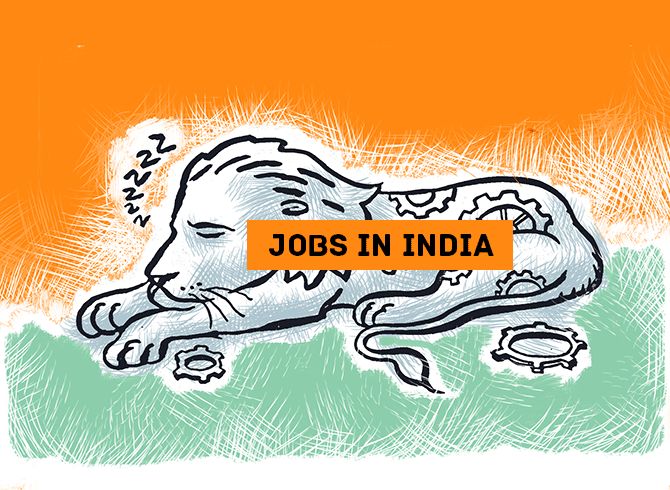'The high unemployment rate therefore being witnessed today is not only the highest in three years, but is far more debilitating for the economy than the similar unemployment rates witnessed in 2016,' explains Mahesh Vyas.

The unemployment rate in India rose to 8.5% in October 2019.
This is the highest unemployment rate in over three years -- highest in 38 months to be precise.
India is reverting to the high unemployment rates that were seen during the first three quarters of 2016.
But the high unemployment rate being experienced in current times is at a much lower labour participation rate than was experienced during 2016.
A far smaller proportion of the working age population today is participating in the labour markets than the proportion three years ago.
And, even these relatively fewer people are not finding jobs at the same rate as witnessed in 2016.
The high unemployment rate therefore being witnessed today is not only the highest in three years, but is far more debilitating for the economy than the similar unemployment rates witnessed in 2016.
The unemployment rate alone does not adequately reflect the stress in the economy and in particular in the labour markets.
A low labour participation rate implies that fewer people are willing to work.
In 2016, 47% to 48% of the working age population was willing to work of which 8% could not find jobs.
Today, only 43% of the working age population is willing to work and of these again, 8% cannot find jobs.
This means that the economy is able to provide jobs to a smaller proportion of the working age population.
Jobs haven't shrunk between 2016 and 2019, but the proportion of working age people who are employed has shrunk.
This proportion -- of the employed to the working age population -- is called the employment rate.
The employment rate is a better reflector of the health of the economy than the unemployment rate.
The unemployment rate is a ratio of the unemployed to the working age population that is willing to work.
It therefore considers only a part of the working age population -- the part that is willing to work.
The concept of unemployment is important to deal with a limited problem -- that of the openly unemployed.
It tells us how much investments need to grow to absorb labour that cannot find jobs.
An 8% open unemployment rate is high which requires urgent attention.
And in this respect it is worrisome that investments are not growing.
But a bigger problem is of the larger numbers who should be looking for work but are not.
It is important to restate the labour markets problem in India.
It is about increasing the low labour participation rate and also reducing the high unemployment rate.
The rising unemployment problem is only one half of the problem, possibly a simpler problem than the problem of low labour participation rate.
The employment rate, which is a better reflector of the economy's health, was 39.5% in October 2019.
This is among the lowest employment rate recorded since January 2016.
The employment rate has been falling steadily since 2016 when it averaged at about 43%.
By August 2018 it had fallen below 40%.
Since then, the rate has been largely below 40%.
But, it hasn't been falling much below this. The average employment rate between August 2018 and October 2019 was 39.8%.
It is imperative that the employment rate rises.
The unemployment rate is an inadequate measure.
When the unemployment rate was at its lowest level in July 2017, the employment rate was not correspondingly high. In fact, it was lower than its earlier levels.
The inadequacy of the unemployment rate is evident from this simple comparison of the rate in July 2017 with its earlier levels.
In July 2017, the unemployment rate was 3.4%.
This was less than half the 9.7% rate over a year ago in May 2016.
It was also significantly lower than the 4.1% unemployment rate a month ago, in June 2017.
However, such a sharp fall in the unemployment rate did not improve the employment rate.
The employment rate in July 2017 at 42% was lower than it was a year ago and also a month ago.
Perhaps, it makes a lot more sense to use the monthly employment rate as a leading indicator of the health of the economy.
Since this indicator is derived from households it covers all sectors of the economy -- the organised and unorganised, large, medium, small and micro organisations, formal and informal employment, etc.
Finally, what matters is employment, not unemployment.
Next, what matters is wages and wage rates. We will get to these measurements soon.
Mahesh Vyas is the MD & CEO of CMIE.










